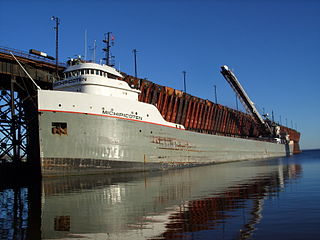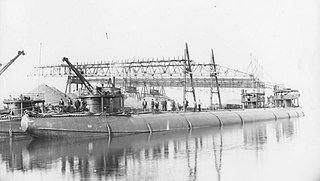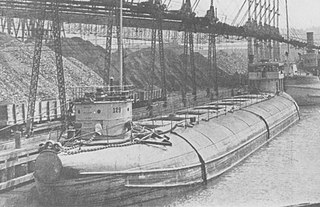
Duluth is a port city in the U.S. state of Minnesota and the county seat of St. Louis County. Located on Lake Superior in Minnesota's Arrowhead Region, the city is a hub for cargo shipping. Commodities shipped from the Port of Duluth include coal, iron ore, grain, limestone, cement, salt, wood pulp, steel coil, and wind turbine components. Duluth is south of the Iron Range and the Boundary Waters Canoe Area Wilderness.

A whaleback was a type of cargo steamship of unusual design, with a hull that continuously curved above the waterline from vertical to horizontal. When fully loaded, only the rounded portion of the hull could be seen above the waterline. With sides curved in towards the ends, it had a spoon bow and a very convex upper deck. It was formerly used on the Great Lakes of Canada and the United States, notably for carrying grain or ore. The sole surviving ship of the "whaleback" design is the SS Meteor, which is docked in Superior, Wisconsin, as a museum ship.

The SS Christopher Columbus was an American excursion liner on the Great Lakes, in service between 1893 and 1933. She was the only whaleback ship ever built for passenger service. The ship was designed by Alexander McDougall, the developer and promoter of the whaleback design.

James William Troup was an American steamship captain, Canadian Pacific Railway administrator and shipping pioneer.

The SS Superior City was considered a pioneer vessel at her launching in 1898. She was the largest vessel ever built on freshwater at that time. She sailed the Great Lakes for twenty-two years until she sank after a collision in 1920 with the steamer Willis L. King in Whitefish Bay of Lake Superior that resulted in the loss of 29 lives. Controversy was immediate over the collision. It was subsequently ruled that the captains of both ships failed to follow the “rules-of-the-road”. Controversy started again in 1988 when the Great Lakes Shipwreck Historical Society produced a video called "Graveyard of the Great Lakes" that included extensive footage of the skeletons of the Superior City crew. The controversy continued as late as 1996 over artifacts removed from her wreck. She is now a protected shipwreck in the Whitefish Point Underwater Preserve.

Henry Darling Coffinberry was an American industrialist from Cleveland, Ohio. Along with his partner, Robert Wallace, H. D. Coffinberry is considered one of the founding fathers of modern Great Lakes shipping. Following a memorable Civil War career on the ironclad gunboat Louisville, Coffinberry returned to civilian life in Cleveland, Ohio. There he met Robert Wallace and together they built the first iron- and steel-hulled freighters to be used on the Great Lakes.

R. J. Hackett was a steamer built in 1869. When first launched, the ship's wide cross-section and long midships hold were unconventional, but the design's advantages in moving cargo through the inland lakes spawned many imitators. The Hackett is recognized as the first Great Lakes freighter, a vessel type that has dominated Great Lakes shipping for over 100 years. In 1905, the Hackett caught fire and sank on Whaleback Shoal in Green Bay, 9.5 miles (15.3 km) southeast of the Cedar River in Menominee County, Michigan. The wreck site was listed on the National Register of Historic Places in 1992.

Captain Alexander "Sandy" Allan, was the Scottish sea captain and businessman who founded the Allan Shipping Line in 1819. Rising from shoemaker to shipping magnate in little more than thirty years, Allan retired in 1839 having made a fortune and created a transatlantic dynasty. He is recognised as one of the major contributors to Scotland's commercial interests in the early 19th century, and to the establishment of the Firth of Clyde as an international centre of shipping. During the Napoleonic Wars his brig Jean – so named for his wife – held the record for the fastest crossing between the Firth of Clyde and Quebec City. Under his five sons, the Allan Line became the world's largest privately owned shipping empire.
Leif Erikson is a Viking ship replica built to commemorate the voyage of Leif Erikson who is credited with reaching North America over one thousand years ago.

Harry Coulby was a British American businessman known as the "Czar of the Great Lakes" for his expertise in managing the Great Lakes shipping fleet of Pickands Mather & Company and the Pittsburgh Steamship Company. After retiring, he served as the first mayor of the newly incorporated town of Wickliffe, Ohio. His former home, Coulallenby, now serves as the city hall of Wickliffe. He chose the design for Great Lakes ore carriers in 1905 that became the standard for the next 65 years, and was elected to the National Maritime Hall of Fame in 1984.

The SS Benjamin Noble was a lake freighter that operated on the Great Lakes. Built in 1909 by the Detroit Shipbuilding Company, she was 239 feet (73 m) in length and had a beam of 40 feet (12 m). She was built as a "canaller," a vessel designed for use in what were then the dimensions of the Welland Canal, but was converted by her owners for services in the open Great Lakes. Heavily laden and top-heavy with a cargo of railroad rails, she sank in a Lake Superior storm near Knife River, Minnesota, in April 1914 with the loss of all hands.

SS Onoko was an iron hulled Great Lakes freighter. She was launched in 1882 in Cleveland, Ohio as hull number #4, and sank on September 14, 1915 in Lake Superior near Knife River, Minnesota. Onoko is thought to be the prototype for every single steel hulled Great Lakes Bulk carrier that ever sailed. These vessels made possible the cheap transport of bulk cargoes such as iron ore, coal and limestone. Her wreckage still remains on the bottom of Lake Superior and was listed on the National Register of Historic Places in 1992.

The Superior Shipbuilding Company was originally called the American Steel Barge Company, and based in Duluth, Minnesota. It was founded by Scottish Captain Alexander McDougall who founded it so he could produce his new whaleback ship, this was Whaleback Barge 101. In 1900 McDougall sold his firm to the American Ship Building Company which transferred the company to Superior, Wisconsin and renamed it Superior Shipbuilding Company, also called AmShip Superior. After World War I the yard stopped manufacturing ships and instead turned to repair work. They continued repairing ships until 1945 when American Ship Building Company decided to sell it. It was initially known as the Knudsen Brothers Shipbuilding & Dry Dock Company. In 1955 it was renamed Fraser-Nelson Shipyards then Fraser Shipyards and still exists today. Fraser Shipyards does dry dock work, also conversions: steam to diesel and coal-fired to oil-burning. Lake Assault boat builders operate out of Fraser Shipyards.

SS Margaret Olwill was a shipping vessel originally constructed in 1887 to transport goods on Lake Erie. It was rebuilt twice to new specifications. It was wrecked in 1899 in an unexpected June storm with the loss of at least eight lives.

Michipicoten is a self-discharging lake freighter owned and operated by Canadian shipping firm Lower Lakes Towing. Michipicoten primarily hauls taconite from Marquette, Michigan, to the Algoma Steel Mill in Sault Ste. Marie, Ontario. It has a capacity of 22,300 tons, a speed of 12 knots (14 mph), and a length of 689 feet 6 inches (210.2 m).

The SS Samoa was a 1,997-ton cargo ship that was able to escape an attack off the coast of California in the early days of World War II. The Samoa was built under a United States Shipping Board (USSB) contract in 1918 as the SS Muerthe, but was launched as the USS Lake Pepin, named after Lake Pepin, by the McDougall Duluth Shipbuilding Company of Duluth, Minnesota measured at 3,600 tons deadweight. She had a triple expansion engine steam engine with 1,250 horsepower (930 kW), a 251-foot (77 m) length, 43.5-foot (13.3 m) beam, a draft of 17 feet 8+1⁄2 inches (5.398 m), a top speed of 9.25 knots. The vessel had a crew of 52, with the hull # 9 and O.N.ID # 21699. The USS Lake Pepin was owned and operated by the United States Navy, commissioned at Montreal, Quebec, Canada on 4 September 1918. For World War I she was fitted with one 3"/50 caliber gun. The Navy put her in Naval Overseas Transportation Service as a coal carrier traveling between the United Kingdom and France as a United States Navy Temporary auxiliary ship. Her coal service ended in May 1919. In June 1919 she returned to the US with a cargo of World War I vehicles and weapons and unused ammunition. The US Navy decommissioned the Lake Pepin on 18 June 1919. In 1923 she was, renamed Samoa purchased and operated by the Hammond Lumber Company. In 1936 she was sold to the Wheeler Logging Company of Portland, Oregon. In February of 1941 she was sold to W. A. Schaefer Company.


Overlakes Freight Corporation was shipping agent company founded in New York City on April 21, 1932, by William M. Nicholson. Overlakes Freight Corporation operated Liberty Ships during and for post World War II efforts. Most of Overlakes Freight Corporation ships were purchased by the War Shipping Administration for the war. Nicholson also owned the Nicholson Universal Steamship Company, Nicholson, Erie, Dover, Ferry Line, Nicholson Terminal & Dock Company, Aqua Terminal & Dock Corporation and the Nicholson Transit Company.

















